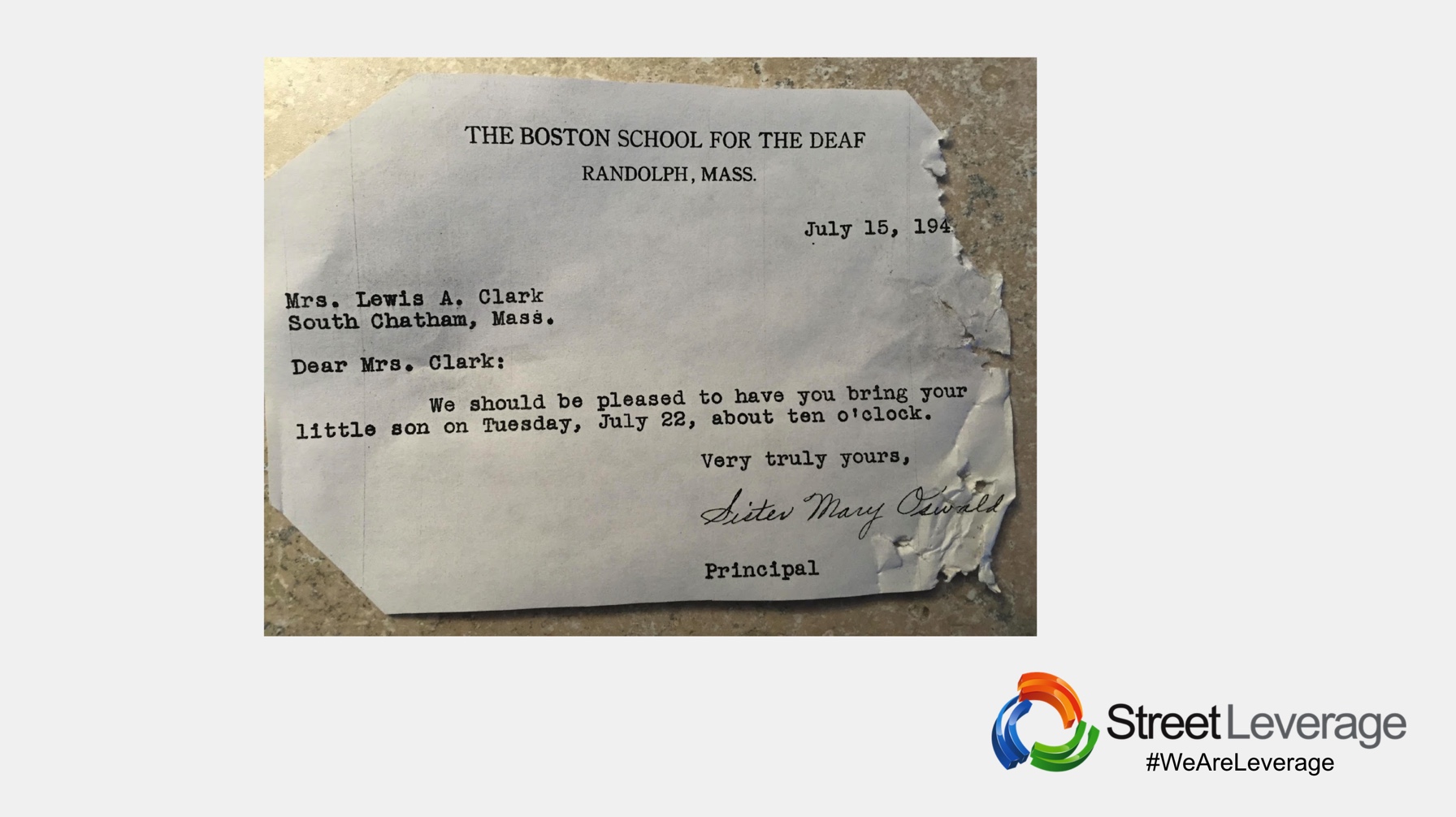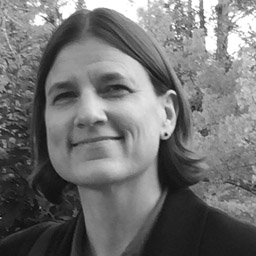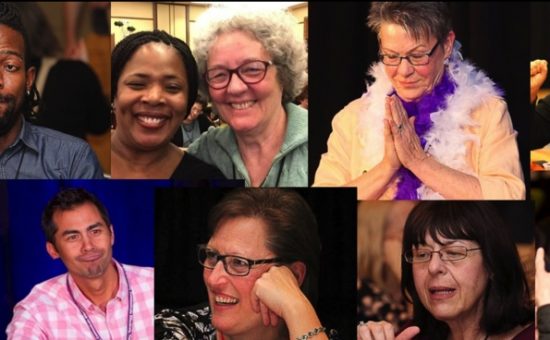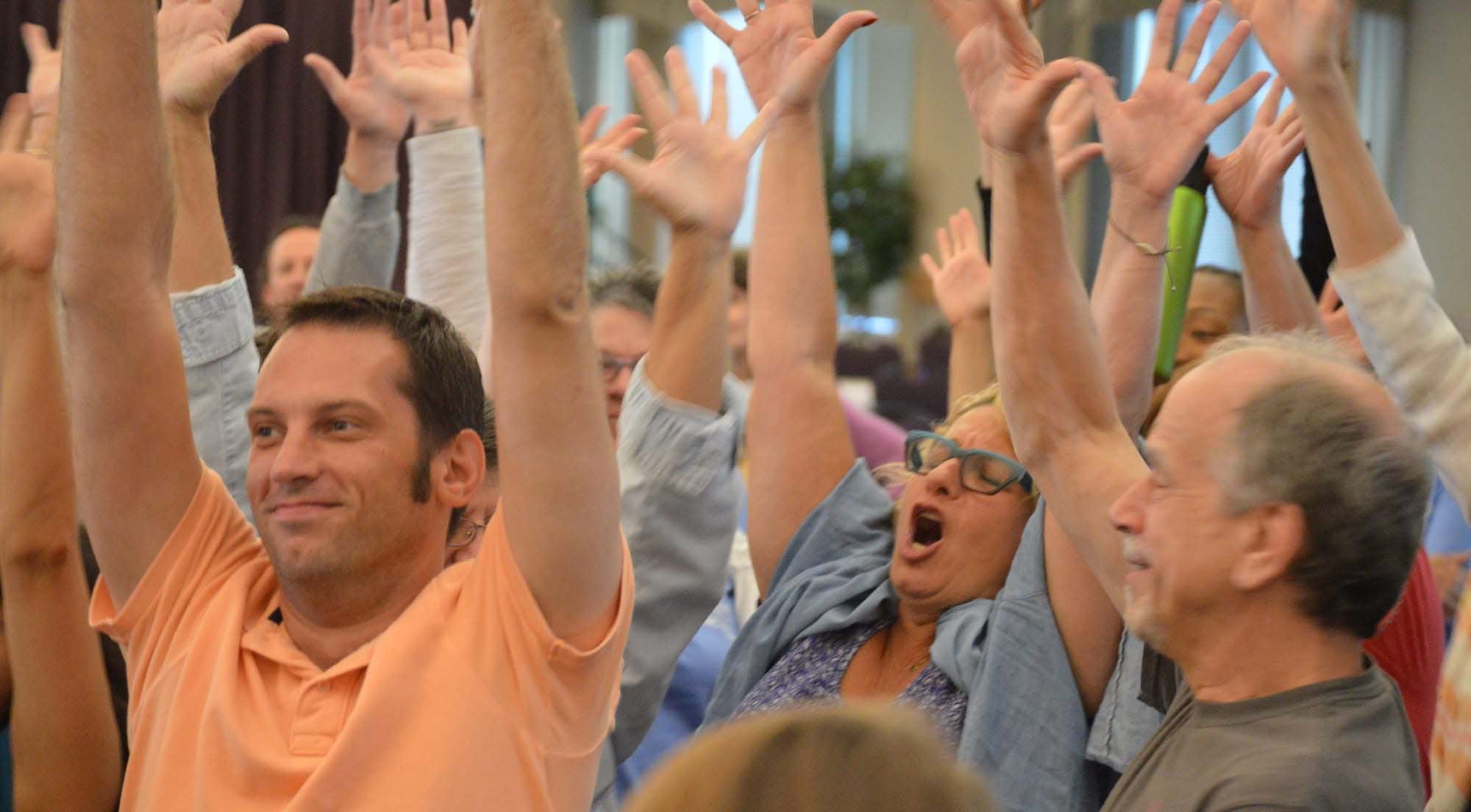The Open Process Interpreting Model: The Power of Language
Stephanie Clark presented The Open Process Interpreting Model: The Power of Language at StreetLeverage – Live 2018 | Cherry Hill. In her presentation, Stephanie shares her perspective on power-sharing with the Open Process Interpreting Model and describes how we can make more conscious, insightful choices with Deaf consumers as equal contributors to the interpreting process.
You can find the PPT deck for her presentation here.
[Note from StreetLeverage: What follows is a translation of Stephanie’s StreetLeverage – Live 2018 presentation. We would encourage each of you to watch the video and access her original presentation directly.]
The Open Process Interpreting Model: The Power of Language
Before we can look at how the power of language ties to the Open Process Interpreting Model, we first need to take a step back to understand the Open Process Interpreting Model, its origins, and its impact on the field of interpreting.
There were two shapers of the Open Process Interpreting Model. One of those people is Molly Wilson. As you are probably aware, the Deaf World operates in a collectivist, interactive, dialogic way, engaging community members in critical conversations. With that in mind, I would like to invite Molly Wilson to the stage to share a few words as she is here with us today. Molly?
Molly: Thank you, Stephanie. I am thrilled you are presenting here today.
I will keep my comments brief and share a bit of the history of the Open Process model. I entered the interpreting field some time ago – in the 1980s; I will not specify the year. I come from an expansive Deaf family. A significant number of family members are Deaf from all sides. I grew up not interpreting FOR but interpreting WITH my family. Interpreting was an act undertaken in solidarity – with others, together. It was never me alone, solitary as the interpreter. Interpreting was interaction with aunts, uncles, cousins – there was interplay and exchange. When I entered the formal world of interpreting, I was quite taken aback. It required a radical shift in my thinking. The Deaf World was to be set aside to allow the interpreters to take charge of the process, focusing on English, on structures. It felt as if culture, and everything that encompassed the Deaf World, was set aside to extract the language – as if that was the only thing interpreters were interested in. The context, such as language, culture, and lived experiences, was not seen as relevant. Many times, I experienced quite a disconnect trying to operate in that reality.
Why must interpreters make all the decisions for Deaf people in interpreted situations?
Later on, I met Vivian Berry. As it happened, the Universe dropped a gift in our laps one day. This gift came in the form of an assignment not having any seats for us. At the time, the typical set-up with a team of interpreters was awkward for all involved. The interpreters were next to the Deaf person, or sometimes, one was seated behind them. This set-up put them out of the Deaf consumer’s field of vision, which was uncomfortable and unnatural. This particular moment was a gift as we were forced to stand. We were not sure at all how to proceed but had several options available to us. We shared options with the Deaf consumer who had their own idea about what might be most effective. Then, the hearing consumer(s) joined in the process, and we went from there. That moment was a realignment for me. That process was a more natural, more organic approach that suddenly opened up the process. It might also have been vegan (laughs), but definitely organic. So that idea of an open dialogue involving all parties was a revolution to me. Why must interpreters make all the decisions for Deaf people in interpreted situations? We are there for their communication event. We are there for their needs, not to split into separate silos of communication and decision-making with the interpreters paired off, away from everyone else, not to shunt Deaf people aside in their own communication event.
So, that was really the first step in developing the Open Process Interpreting model. I said I would keep it short so you can delve more into the details. I am thrilled Stephanie is here to share a Deaf Interpreter’s perspective on the model. We have discussed the importance of deepening this conversation and finding new ways to identify to whom this process belongs. Taking language outside of the context of language, culture, worldview, and experience is not natural. Reintegrating language with these other components brings everything back to its rightful place, as it should be. Thank you.
Stephanie: Thank you.
Molly talked about ownership of the process. We need to start there. We have to take a step back to evaluate how that is tied to the power of language.
The Power of Language
If we are going to talk about language, we have to start by acknowledging that language is the root of the interpreting field. As a Deaf Interpreter, for example, I bring my lifelong experience in the Deaf World. In that world, interpreting, clarifying, expanding, and discussing concepts is a natural part of interactions and engagement. So, that brings us to the conversation about who owns the process. Here is an example. I grew up in my family with several siblings, all of us Codas. I was the youngest of four. At dinner, we would all come together and talk about various topics. We all took part in and had ownership in those conversations together. In the interpreting field, we tend to label things. By contrast, my family never labeled anyone as “hearing.” We did not label each other in that manner. We identified our relationships (brother, sister), and we all had Deaf parents. For example, my label might be “the baby sister”, but we had no label such as “hearing” to identify each other. Eventually, the term “Coda” was added to our lexicon. My point, however, is that our language never became so automated or dictated that we assigned more reductive labels to each other like “hearing.” Another example came up in the interpreting field. As I was taking coursework to become a Deaf Interpreter, the term “boundaries” came up. The conversation was that interpreters must establish boundaries and the importance of doing so. In my formative years, the term “boundaries” was not used. I recognized that a shift had occurred from our origins, from our roots, moving us into a place where everything was labeled and defined. That process took me from a more grounded space to becoming more automatic and less fluid in my interpreting. It created a dissonance that I had to examine. As I started to reflect on this, I realized that there were two aspects I had to consider. As a Deaf person, I had my own interactions and experiences with various interpreters. With some interpreters, there was a connection, a rapport, that I felt. I wondered why that rapport was present with a few interpreters? I looked at how they interacted with Deaf people, and what I realized was that those interpreters I felt more rapport with used an Open Process Model of interpreting approach. Their interaction style brought me a sense of ease. Let me share an example to illustrate what I mean.
Some years ago, my father took a fall which left him paralyzed from the neck down. What this meant was that he was unable to sign at all. One day while he was in the hospital, a team of interpreters came – one Deaf and one hearing. They interpreted the appointment. After the examination was complete, the doctor told my father that he would never walk again due to the damage to his spine. He was paralyzed from the neck down. What that really meant was that my father would never sign again. He had been raised in and lived in a signing environment his entire life. Due to this paralysis, he was unable to move his body from the neck down. The Deaf Interpreter conveyed the doctor’s words to my father, “You will not walk again.” My father, unable to respond in ASL, mouthed, “Won’t walk again?” The Deaf interpreter responded, “No.” And so it went with the Deaf and hearing interpreters conveying each part of the conversation. Eventually, the hearing interpreter stopped the proceedings to address my father directly. The interpreter told him, “You will not walk again.” My father mouthed back, asking multiple times, “I won’t walk again?” The interpreter stayed with the conversation, responding each time. Eventually, the interpreter also engaged my siblings and me in the process. Each of us gave this message to my father until, finally, it became a reality for him. At the same time, it eased the situation for him to come to terms with this realization in that manner.
In looking at that, we can look at the Open Process Model of Interpreting and the power of language. One concept involved is turn-taking and the idea that if a Deaf consumer asks a question, we must always simply interpret the question without involving ourselves in the dialogue. In the situation with my father, the interpreter realized that path was not effective. The message was not being clearly conveyed to my father. The interpreter involved everyone in the process during this critical conversation. That process worked for him, and he was able to receive the message and experience some ease from the way the situation was handled. This was a powerful experience for me. That interpreter utilized the Open Process Model of Interpreting in their regular freelance practice, as well. So I started to examine the role of a Deaf interpreter, the role of hearing interpreters, and Coda interpreters, and how we could all share space together. It is something that warrants further investigation. So when we look at the power of language, we have to take the additional step of looking at language ownership and language ideologies.
Language Ownership and Language Ideologies
Language ideologies are tied to the conversation about language ownership. For example, Deaf people own ASL. When we talk about the spaces where that language takes place, Deaf people own that, as well. More broadly, the Deaf World owns ASL and those spaces and this includes anyone raised in the Deaf World, including Deaf people, Codas, etc., and we all own language processes together. If we step back even further to look at the ownership of language processes, and if we examine the field of interpreting, we can look at the emergence of Deaf interpreters who have recently started formal training. Looking back at our history, we can see that Deaf Interpreters have always been a natural part of communicating in our world. It was only recently that we established this more formal, more structured curriculum. That formalized structure has caused our actions to become more automatic and less natural. We adhere to a more strict set of standards that dictate behavior, such as managing logistics with other interpreters, etc.
It was a validation of our community process, our approach of using open dialogue and engagement.
For example, the practice of placing the Deaf Interpreter directly across and facing the Deaf consumer with the hearing interpreter located behind the Deaf consumer and out of their line of sight. Where did this idea come from? Who decided that was the method to teach? This is not a natural way to physically set up the interpreting environment. In my own experience using interpreters through the years, the interpreter was never located behind me, signing where I could not see them. It is not natural, and I felt a strong disconnect. I wondered about this. When I was eventually able to take Molly’s workshop, we discussed this issue. I realized I had found what I was seeking. It was a validation of our community process, our approach of using open dialogue and engagement. I was able to adapt the things I had learned in my training to incorporate this approach. For example, instead of having the hearing interpreter out of sight behind the Deaf consumer, we can triangulate. We can all see each other that way. Why are we hiding the process when there is no reason to do so? This method allows the Deaf consumer to see both the Deaf and hearing interpreters at the same time. So that is one example of adapting the environment to meet the expectations of the consumer more effectively.
I will give you a second example. If we all own the process together, does the Deaf Interpreter always have to reinterpret everything the hearing/coda interpreter signs, without exception? Do we have to adhere to that model 100% of the time? Where did that idea originate? That wasn’t something that we learned in school – there was no strict rule that information always had to flow from A to B to C in a rigid manner. Again, this structure created a disconnect for me. With the Open Process Model, the Deaf consumer may see the hearing/coda interpreter’s rendition of the message and that may be all they need. If they understand the message clearly, there is no need for the Deaf Interpreter to create a new interpretation. Additions and clarifications can happen easily in this process. The Deaf consumer may contribute to the conversation. If the hearing/coda interpreter gets the information clearly from the Deaf consumer, they can proceed with their ASL to English interpretation. They do not have to wait for a reinterpretation. The process does not have to follow a specific, prescribed path in this model. It seems like we have gotten married to the idea of establishing a structure and strictly adhering to it.
This process is not bound to a person’s hearing status, rather it is defined by our formative experiences, what we bring to the table as tools we can use.
The power of ideology – understanding where that ideology comes from and examining it is important. This process is not bound to a person’s hearing status, rather it is defined by our formative experiences, what we bring to the table as tools we can use. That approach, the Open Process, challenged my approach and my thinking. Now, as I enter a situation, I think about formative experiences. In a given situation, based on the other interpreter’s formative experiences, it may be best for them to take the lead and start. Perhaps they are a coda or someone who went to a Deaf residential school, and they have that socialization experience which may create a connection with the consumer. I did not have that experience – I attended a mainstream school, and my parents were Deaf. Our formative experiences are different which can help as we work together. Having that Open Process allows the Deaf consumer to develop some trust and ultimately, the situation will go more smoothly based on that rapport.
A third example of ideologies is the idea that a Deaf Interpreter must always take the lead. There is this belief that the Deaf Interpreter must take charge and determine the physical logistics in the setting rather than having a discussion. It is possible that my coda or hearing counterparts have some background information, or they may have some familiarity with the environment. In those instances, they should be able to take the lead. The question of who is to lead requires more discussion than a bound process allows. If we all share in the ownership of the process, what can that look like?
I have been able to identify several places where the Open Process Model has been very successful. One personal example happened when I was attending the NAOBI conference a number of years ago. I went to a panel discussion that was conducted in spoken English. Each panelist had a designated interpreter standing behind them. I was watching from the audience. In the course of the discussion, a term came up related to kitchens to which I had a visible reaction of confusion. One of the interpreters saw my response and reacted by providing a brief explanation of the point. I was able to engage and get the information I needed. So, we need to think about the expectations and rules established for the audience. If an interpreter is working and the team sees some confusion from a Deaf audience member, they could take a moment to clarify. That was traditionally the Deaf way – to clarify at the moment. In my experience growing up, if a Deaf person was signing to a group and someone missed something or was confused, often another person would clarify the point for them. It was always an open part of the process; it was not something hidden from view. Our training now tells us we have to keep our boundaries separate. We have to take responsibility for clarifying the message alone, or we have to clarify directly with the person after the event is over. Why is that? Why hide the process? It is fine to include our audience in the process. This started me thinking about our role in Open Process and what that looks like, whether it be a large or small audience, a workshop, a one-on-one situation, etc. I think this will require some discussion, reflection, and analysis. We have to ask ourselves, what is our goal in getting the message out? Who is the message intended to reach?
I will share another personal experience with you, one that involved my mother and how all of this impacted her life. My mother had a stroke and was placed in the hospital. The interpreter entered the room and announced, “This is my client.” She labeled my mother “my client” and then started interpreting. My siblings and I were then excluded from the discussion with the doctor. We were all there, wanting to participate in the conversation that was happening. She would have none of it. In her mind, the communication was between the medical professionals and my mother. She did not welcome our participation as Codas at all. Our desire to participate did not fit her picture of what should be happening. She was there to interpret between the medical staff and our mother. There were times when we had information to share or wanted to add something to the discussion, but she did not include us. She eventually left.
It was more proof that the Open Process Model of interpreting allows deaf people to feel more at ease in the process, to feel more comfortable.
When she returned, my now ex-wife was with me. We were seated together when she entered the room. We both looked at my mother’s blood pressure monitor and saw her blood pressure immediately go up. As soon as that interpreter came into the room, my mother’s blood pressure started to rise. When she left, her blood pressure would go back down again. We were both shocked at this realization. Later, a different interpreter, one who is more open and engaging with everyone, came in. Upon entering the room, she made eye contact and took in everyone who was there. In the course of her interpreting, she accepted additions and clarifications throughout the conversations. During that interpreter’s shift, my mother’s blood pressure remained stable and in an acceptable range. We noted that as well. A different interpreter came, and again, my mother’s blood pressure went up. After that, we started to identify the interpreters who caused her blood pressure to increase, who caused her stress. The stress came from her experience of having been taught to “grin and bear it,” to put on a happy face and tell everyone that everything was fine even when it was not. Those interpreters who caused her stress saw her pasted-on smile and took it at face value, assuming that everything must be fine, even as her blood pressure indicated the opposite. We were amazed by this realization. We had proof that her stress level was affected emotionally, physically, spiritually, even if she outwardly indicated all was well. It was more proof that the Open Process Model of interpreting allows deaf people to feel more at ease in the process, to feel more comfortable. That was a huge realization. It had worked for my mother, it had worked for my father, and it worked for me. I started to consider the next steps. How can we change the field of interpreting?
For me, I had to start by examining my own power and privilege. Upon entering any situation, I must ask the question, “Why am I here? Who owns this process?” The Deaf person does. A good example of this is the video relay service – VRS. When a Deaf person places a call, an interpreter appears on-screen. The Deaf caller sees one interpreter as the call proceeds until eventually, the interpreter switches out with their team. All this time, the Deaf person has had no idea there was an interpreter team present for their call or that this person may have been watching their communication without their knowledge the entire time. That is not natural. In the Deaf world, notifying the caller that you were bringing in a team interpreter would be a more culturally appropriate way to handle this, to have both interpreters on-screen and show their process in the open. By doing this, the interpreter would allow the Deaf person to be aware of the process, and to feel confident in proceeding. Having both interpreters on-screen rather than one person hidden off-screen would open the process. Why is that part of the process hidden? Could VRS interpreters notify the Deaf person that they have called a team, invite them on-screen, and use an open process to work through the call? That kind of transparency would generate a higher level of trust and would likely make the call go more smoothly. That is one example from VRS, but there are examples from many other situations where the process is kept hidden and would benefit from opening up and providing more transparency. We need to talk about how to shift from hidden processes to using more open processes. So again, VRS is one arena where this occurs.
Another example that comes to mind is the clarification process. A good example is from Betty Colonomos’ discussion about affect. In the field, interpreters, whether they are Deaf, Coda, or hearing interpreters, experience challenges in discussions about affect. Given a single signer to view, twenty different interpreters will each interpret the signer’s affect differently. The range of responses will typically be broad, describing everything from a mild response to a passionate one with every variation in between. Instead of spending our time discussing and deciphering their intent, why don’t we simply ask the person? We can ask the person, “Are you angry?” “Are you passionate or are you showing your concern?” The Deaf person will typically respond by sharing their true intent. Asking the person for clarification is an easy way to resolve this issue. That process of including people in the decision-making process is something I believe we need to talk about in the field.

We came across that document after my mother passed away last fall. It was a letter from when my father acceptance to the Boston School for the Deaf. If you look at the language in that brief message, “We should be pleased to have you bring your little son…” That phrase, “should be pleased,” was discussed and analyzed by over fifty different people. Each person had a different perspective on the intent and meaning of that simple phrase. Their thoughts ranged from those who thought the writer was truly pleased and moved to welcome my father to those who felt it was a perfunctory, more negative response while still others thought it was an excited and happy welcome. More than fifty different responses for that one phrase. Now, suppose one or two interpreters decided to interpret that message alone without input? All parties must be involved in the process.
How Do We Align Our Words?
So, how do we align all these things? How do we take our labels and align them with our tone, history, life experiences, conversations, and language? We have to engage in thoughtful dialogue about how we will approach this task.
This Is Us
For us to start the dialogue about the Open Process Model, we need a space to do it. Some people think we need a “safe space”, but there is no such space. Nor is there such a thing as “brave space.” What is required, then, for this dialogue to occur, is authentic space. To have the kind of in-depth, authentic discussion indicated, we need to delve into how the Open Process Model applies to the field. That kind of authentic discussion requires us all to come together to participate because this is us.













